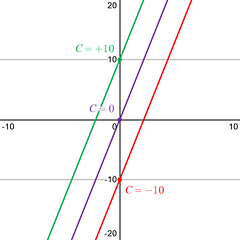Example 1: Antiderivative of a Constant
|
|
Definite Integral |
Indefinite Integral |
|
|
|
|
|
Step 1: Simplify and look for algebraic rewrites.
None here. |
|
|
|
Step 2: Identify any term(s) that are just a constant. The only term in either example is just a constant, 5. |
|
|
|
Step 3: Take the antiderivativeof the constant using the Recipe: Numbers by themselves, constants, gain a letter back. |
|
DO NOT FORGET THE +C |
|
Step 4 ( Definite Integral ONLY ): Evaluate the antiderivative result using the Top – Bottom method. |
|
|
|
Final Result Meaning: Remember the Definite Integral will always provide you a definite value , and the Indefinite Integral provides you a family of solutions . |
The Net Area between the curve and the x-axis on the x-interval [ 3 , 7 ] is 20. Since the final result is positive, you know without even seeing the graph that there is more area above the x-axis than below it.
|
The antiderivative of the equation is the family of graphs .
All graphs of the form have the same derivative (instantaneous rate of change), , at any x-value . The only difference between any of original graphs, , is just a vertical shift of +C . In the graph above are examples of 3-different C-values. You can see the instantaneous rate of change ( slope ) is the same at every x-value between all the different examples, no matter the +C . |



